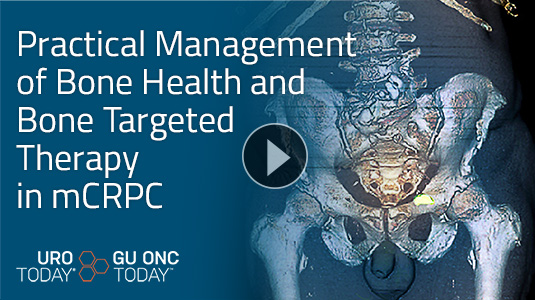- UroToday Home

- Center Of Excellence
Centers of Excellence
mCRPC with Bone Metastasis
Continued Focus on Bone Metastases to Improve Outcomes and Patient Care in Prostate Cancer
Bone metastases are at the center of advanced prostate cancer care, with over 90% of patients with metastatic prostate cancer expected to have bone involvement.1 These metastatic sites can be a cause of substantial pain in our patients, and they have been a key target for therapeutic development. Bone targeted agents have been developed to reduce fragility fractures and skeletal related events, and are now an integral part of the care of patients with metastatic prostate cancer,2,3 Further, radium-223 is a bone-targeted radiopharmaceutical that not only reduces pain burden but was also the first radiopharmaceutical to prolong survival in patients with prostate cancer. Over time prostate cancer studies have investigated the prognostic implications of bone metastases in comparison with other sites and helped us gain insight into the potential future progression or responsiveness of disease.4 Bone metastases have played a large role in the clinical care of patients with prostate cancer, and our approach to them continues to evolve.

Alicia Morgans, MD, MPH, is a Genitourinary Medical Oncologist and the Director of the Survivorship Program at Dana-Farber Cancer Institute. A clinician and investigator, she has expertise in clinical trials and patient-reported outcome measures, as well as incorporating patient preferences and beliefs into clinical decision making. Her research has investigated complications of systemic therapy for prostate cancer survivors, including the study of skeletal, cardiovascular, diabetic, and cognitive complications. Her work has been funded by grants from the Prostate Cancer Foundation and the Department of Defense. She is a member of the advanced and localized prostate cancer treatment guidelines committee of the American Urologic Association, and is a member of the cardio-oncology committee of the American Heart Association. Since 2016, she has been President of the Medical Advisory Board for ZERO, a non-profit organization dedicated to supporting education and research funding for prostate cancer research.
Introduction
Radium-223 dichloride (radium-223) is a targeted alpha emitter that selectively binds to areas of increased bone turnover in bone metastases and emits high-energy alpha particles of short-range (<100 μm). Radium-223 acts as a bone-seeking calcium mimetic and binds into newly formed bone stroma, especially within the microenvironment of osteoblastic or sclerotic metastases. Double-stranded DNA breaks result secondary to the high-energy alpha-particle radiation. Read MoreIntroduction
The treatment landscape of metastatic castrate-resistant prostate cancer (mCRPC) has long been dominated by androgen receptor pathway inhibitors (ARPIs) and chemotherapeutic agents. There are currently, however, two radioligands that are United States Food and Drug Administration (FDA)-approved for the treatment of mCRPC patients:
Read MorePatients with advanced prostate cancer are at significant risk of skeletal-related events (SREs) due to a complex interplay between bone health and prostate cancer due to cancer biology and the predilection of prostate cancer to spread to bone, the toxicity of prostate cancer treatments, and shared epidemiology of the two conditions.
Read More
Prostate-specific membrane antigen (PSMA)-PET was introduced into clinical practice in 2012 and has since transformed the staging of prostate cancer. Prostate Cancer Molecular Imaging Standardized Evaluation (PROMISE) criteria were proposed to standardise PSMA-PET reporting.
Read MoreScientists at The University of Texas MD Anderson Cancer Center have engineered a system allowing microscopic monitoring and imaging of cancer that has spread to the bone in mice so they can better understand and develop treatment for bone metastasis in humans.
Read More
Read More
Read More
The landscape of metastatic prostate cancer has changed recently with the availability of six new molecules showing an overall survival benefit. The development of compounds able to decrease the rate of complications from bone metastasis has also led to improvements in overall morbidity associated with this disease.
Read MoreIn the previously reported ALSYMPCA trial in patients with castration-resistant prostate cancer and symptomatic bone metastases, overall survival was significantly longer in patients treated with radium-223 dichloride (radium-223) than in patients treated with placebo.
Read MoreOBJECTIVE - Prostate cancer (PC) is the most common cancer in Western countries. Recent advances in the treatment of metastatic castration resistant prostate cancer (mCRPC) have caused significant pressure on health care budgets.
Read MoreBACKGROUND - Radium-223 dichloride (radium-223), a first-in-class alpha-emitting radiopharmaceutical, is recommended in both pre- and post-docetaxel settings in patients with castration-resistant prostate cancer (CRPC) and symptomatic bone metastases based on overall survival benefit demonstrated in the phase 3 ALSYMPCA study.
Read MoreBACKGROUND - Radium-223 is a bone-targeting radiopharmaceutical that extends survival in mCRPC. Postapproval data are limited, and the value of biochemical and radiologic monitoring during radium therapy is unknown.
Read MoreImproving options for patients with metastatic castration-resistant prostate cancer (mCRPC) provide latitude in designing treatment plans that meet patients' medical needs and personal goals.
Read MoreEven when symptoms, such as pain, impose significant impacts on their daily lives, many men with advanced prostate cancer do not report the symptoms to their doctors, according to an international survey of both patients and their caregivers to explore this issue. Symptoms may go unrecognized as being associated with cancer, or men deliberately choose not to speak about them with their doctors. As a result, they may not receive interventions that could ease the discomfort.
Read MoreBACKGROUND - Radium-223 prolongs overall survival in patients with castration-resistant prostate cancer (CRPC) and symptomatic bone metastases, regardless of prior docetaxel. Whether or not chemotherapy can be safely administered following radium-223 treatment is of clinical importance.
Read More












